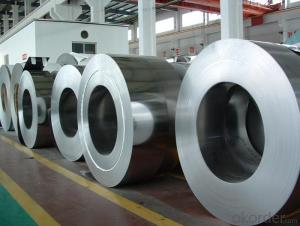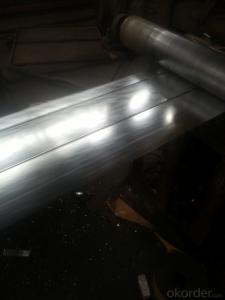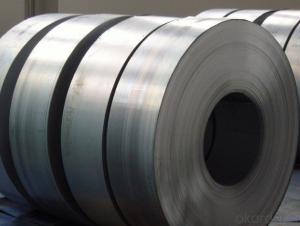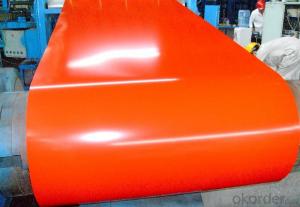Cold Rolled Steel Strip Stainless Steel Strip Coils
- Loading Port:
- China main port
- Payment Terms:
- TT or LC
- Min Order Qty:
- 100 m.t.
- Supply Capability:
- 100000000 m.t./month
OKorder Service Pledge
OKorder Financial Service
You Might Also Like
Packaging & Delivery
| Packaging Detail: | cold rolled stainless steel strip coils is packed in export standard package |
| Delivery Detail: | cold rolled stainless steel strip coils finished within 15 days |
Specifications
1,cold rolled stainless steel strip coils thickness0.2~1.5mm
2.Ensure you quality timely deliver
3.2B finish
4.Tolerance 0.01
Item Details:
1, cold rolled stainless steel strip coils with thickness 0.2~1.5mm
2, Finishing: 2B
3, Width: 15~500mm
4. Tolerance: -0.01mm~0.01mm
Our advantage
1, High quality: Using lastest automated control equipment to ensure china stainless steel coil quality, such as AGC system.
2, Best Price: With most automated equipments to cost down.
3, Fast delivery: Since your order placed, ETD will be only 10 days.
4, Best Sevice: We do believe your encouragement is the best support for us.
Shipping information:
1, Payment terms: T/T 30% for depsoit, Balance against the copy of B/L; or L/C at sight
2, ETD: 10-15 days after the receipt of the deposit
3, Ship terms: FOB Ningbo
4, Minimum quantity: 5 tons
Contact and Feedback:
If you are interested in any of cold rolled stainless steel strip coils or any question, please feel free to contact us. We will reply you within 24H.
- Q:Are steel strips suitable for making surgical instruments?
- Yes, steel strips can be used to make surgical instruments. Steel is a commonly used material in the production of surgical instruments because of its many advantageous properties. Steel strips possess excellent strength, durability, and resistance to corrosion, making them ideal for surgical instruments that must endure constant use and repeated sterilization processes. The hardness and malleability of steel also allow for precise shaping and intricate designs, ensuring that surgical instruments can be crafted efficiently with sharp edges and intricate details. Furthermore, steel is biocompatible, meaning it does not cause negative reactions or harm to the human body. This makes it a safe option for surgical instruments that come into direct contact with patients. In conclusion, steel strips offer the necessary qualities needed to manufacture high-quality, trustworthy, and long-lasting surgical instruments.
- Q:What are the tolerances for dimensional accuracy in steel strips?
- The tolerances for dimensional accuracy in steel strips can vary depending on various factors such as the specific manufacturing process, the intended application of the steel strips, and the industry standards and regulations that govern the production. Generally, dimensional accuracy in steel strips is crucial to ensure their proper fit and functionality in various applications. The tolerances for dimensional accuracy in steel strips typically include measurements such as thickness, width, and length. For example, the thickness tolerance may range from a few micrometers to a few millimeters, depending on the desired precision and the specific requirements of the application. Similarly, the width tolerance may vary depending on the intended use, with narrower tolerances being necessary for applications where precise fit is essential. Length tolerance is another important factor, and it is usually specified to ensure that steel strips are cut to the desired length without significant deviations. This is particularly crucial in industries such as construction, automotive, and manufacturing, where precise dimensions are required for proper assembly and performance. It is important to note that different industries and applications may have their own specific tolerances for dimensional accuracy in steel strips. For instance, aerospace and automotive industries often demand higher precision and tighter tolerances compared to general manufacturing applications. In such cases, the tolerances may be specified in terms of tighter ranges, ensuring more precise and accurate dimensions. To determine the specific tolerances for dimensional accuracy in steel strips, it is advisable to refer to industry standards and regulations that outline the acceptable range of variations for different measurements. These standards are typically developed by recognized organizations and associations, taking into consideration the specific requirements and safety considerations of the industry. In conclusion, the tolerances for dimensional accuracy in steel strips can vary based on factors like manufacturing process, application, and industry standards. It is crucial to adhere to the specified tolerances to ensure proper fit, functionality, and safety in various applications.
- Q:How are steel strips used in the production of hand tools?
- Steel strips are widely used in the production of hand tools due to their durability and versatility. These strips are typically made from high-quality steel alloys, which offer exceptional strength and wear resistance. In the manufacturing process, steel strips are first cut into the desired dimensions and then undergo various forming operations such as bending, stamping, or rolling. This allows the strips to be shaped into the specific components required for hand tools, such as blades, handles, or shafts. The flexibility of steel strips enables the production of a wide range of tool designs to meet different application needs. Once the components are formed, they are further processed through heat treatment, which enhances their hardness and toughness. This treatment ensures that the hand tools can withstand significant force, impact, and wear during use, making them highly durable and long-lasting. Steel strips are also used in the production of hand tool accessories, including springs, clips, or fasteners. These components play important roles in enhancing the functionality and usability of the tools. For instance, springs made from steel strips provide the necessary tension or pressure required for certain hand tools, such as pliers or clamps. Moreover, steel strips can be coated or plated with protective finishes, such as chrome or nickel, to enhance their corrosion resistance and improve the overall aesthetics of the hand tools. This additional layer of protection ensures that the tools remain in good condition even in challenging working environments. Overall, steel strips are an essential material in the production of hand tools, as they provide the necessary strength, durability, and versatility required for various applications. From the blades to the handles, these strips enable the creation of high-quality tools that can withstand rigorous use and deliver exceptional performance.
- Q:How do steel strips compare to titanium or aluminum strips?
- Steel strips are generally stronger and more durable compared to titanium or aluminum strips. Steel has a higher strength-to-weight ratio, making it capable of withstanding heavy loads and high impact situations. Additionally, steel is more resistant to corrosion and extreme temperatures than both titanium and aluminum. However, titanium and aluminum strips are lighter and offer better conductivity, which may be advantageous in certain applications where weight or electrical properties are crucial. Ultimately, the choice between steel, titanium, or aluminum strips depends on the specific requirements of the intended use.
- Q:How do steel strips resist corrosion?
- Steel strips resist corrosion through a process known as passivation, where a thin layer of oxide forms on the surface, creating a protective barrier that prevents further oxidation and corrosion. Additionally, steel strips can be coated with corrosion-resistant materials such as zinc or paint, further enhancing their ability to resist corrosion.
- Q:Can steel strips be used in architectural applications?
- Yes, steel strips can definitely be used in architectural applications. Steel is a versatile and durable material that can be shaped into various forms, including strips, making it suitable for a wide range of architectural uses. Steel strips can be used for cladding, roofing, and siding applications, providing structural support while also enhancing the aesthetic appeal of a building. Additionally, steel strips are often used for decorative purposes, such as creating feature walls or accents, due to their sleek and modern appearance. Overall, steel strips offer architects and designers a flexible and reliable option for incorporating metal elements into their architectural projects.
- Q:How are steel strips transported?
- Various methods are employed to transport steel strips depending on factors such as distance, quantity, and specific requirements. One commonly utilized approach is the utilization of trucks equipped with flatbed trailers. These trailers are explicitly designed to bear heavy loads and possess a level surface to accommodate the steel strips. Typically, the strips are loaded onto the trailer and securely fastened using chains or straps to guarantee their stability during transit. For longer distances or international shipments, rail or sea transport may be employed. In the case of rail transport, the strips are loaded onto specially designed railcars equipped with mechanisms to secure the cargo in place. This mode of transportation is often employed when large quantities of steel strips are involved or when time constraints are not a pressing concern. In the realm of sea transport, steel strips are commonly packed into shipping containers and loaded onto cargo ships. These containers offer optimal protection during the voyage, minimizing the potential for damage caused by external factors such as adverse weather conditions or rough seas. Moreover, containers can be readily transferred between different modes of transportation, making them a flexible option for international shipments. In certain instances, air transport may be employed for urgent or high-value shipments. Steel strips can be loaded onto cargo planes or included as part of larger shipments. However, due to the weight and dimensions of steel strips, air transport is generally more costly and less prevalent compared to other transportation methods. Regardless of the chosen method, it is imperative to ensure the proper packaging, securing, and handling of steel strips during transportation. This necessitates the implementation of appropriate protective measures, such as coatings or covers, to prevent corrosion or damage. Additionally, logistics companies often employ specialized equipment, such as cranes or forklifts, to safely load and unload steel strips at both the origin and destination points.
- Q:What are the specifications for steel strips used in the aerospace industry?
- To guarantee the utmost safety and performance, the aerospace industry imposes stringent and meticulous specifications on steel strips. Here are some of the vital requirements: 1. Composition of Materials: Chemical compositions of the steel strips must adhere to specific standards to meet the desired strength, durability, and resistance to corrosion. Stainless steel, high-strength low-alloy (HSLA) steel, and nickel-based alloys are commonly utilized. 2. Tolerances for Dimensions: The steel strips must conform to precise dimensional tolerances to ensure suitable fit and functionality within aerospace components. This encompasses measurements of thickness, width, and length, often indicated in micrometers or inches. 3. Surface Finish: The surface finish of the steel strips plays a crucial role in minimizing friction, preventing corrosion, and optimizing performance. It is often expressed in terms of roughness average (RA) or surface finish grade. Additionally, additional coatings or treatments may be necessary to enhance surface properties. 4. Mechanical Properties: The steel strips employed in aerospace applications must possess specific mechanical properties, including tensile strength, yield strength, elongation, and hardness. These properties guarantee that the strips can withstand the challenging conditions encountered during flight, such as high temperatures, vibrations, and external forces. 5. Heat Treatment: Depending on the intended use, the steel strips may require specific heat treatment processes to enhance their mechanical properties. This may involve techniques such as annealing, quenching, tempering, or precipitation hardening, with the aim of achieving the desired strength, toughness, or ductility. 6. Certification and Testing: Steel strips used in the aerospace industry undergo rigorous testing and certification procedures to ensure compliance with industry standards and regulations. Non-destructive testing methods, such as ultrasonic testing, magnetic particle testing, or dye penetrant inspection, are employed to identify any defects or flaws. It is important to note that the precise specifications for steel strips utilized in the aerospace sector may vary depending on specific applications, aircraft types, and regulatory requirements. Therefore, it is crucial to consult the relevant aerospace standards and specifications for precise details.
- Q:How are steel strips used in the production of automotive components?
- The strength, durability, and versatility of steel strips make them widely used in the production of automotive components. These strips are typically made from high-quality steel alloy and come in different thicknesses and widths to meet different manufacturing needs. One way steel strips are commonly used in automotive production is for fabricating body panels. Specialized machinery is used to stamp or press these strips into shape, creating components like doors, hoods, roofs, and fenders. The strength of steel allows for thinner panels, reducing vehicle weight while maintaining structural integrity and safety. Steel strips are also commonly used for suspension and chassis components. These strips can be cut, bent, and welded to form brackets, reinforcements, and other parts. The strong and rigid nature of steel ensures these components can withstand the heavy loads and stresses experienced by vehicles. Engine and transmission components are also manufactured using steel strips. These strips can be shaped and then heat-treated or machined to achieve the desired strength and precision. Examples of such components include gears, shafts, valves, and crankshafts. The high wear resistance and heat resistance of steel make it an ideal material for these critical components. In addition to their mechanical properties, steel strips are valued for their corrosion resistance. Automotive components made from steel strips are often coated with protective layers like zinc or paint to prevent rusting and ensure longevity. In conclusion, steel strips are crucial in the production of automotive components due to their strength, durability, versatility, and corrosion resistance. They are used in various applications, from body panels to suspension and engine components, contributing to overall vehicle performance, safety, and longevity.
- Q:Can steel strips be heat treated to improve their properties?
- Yes, steel strips can be heat treated to improve their properties. Heat treatment processes such as annealing, quenching, tempering, and hardening can be applied to steel strips to enhance their hardness, strength, toughness, and other mechanical properties.
1. Manufacturer Overview |
|
|---|---|
| Location | |
| Year Established | |
| Annual Output Value | |
| Main Markets | |
| Company Certifications | |
2. Manufacturer Certificates |
|
|---|---|
| a) Certification Name | |
| Range | |
| Reference | |
| Validity Period | |
3. Manufacturer Capability |
|
|---|---|
| a)Trade Capacity | |
| Nearest Port | |
| Export Percentage | |
| No.of Employees in Trade Department | |
| Language Spoken: | |
| b)Factory Information | |
| Factory Size: | |
| No. of Production Lines | |
| Contract Manufacturing | |
| Product Price Range | |
Send your message to us
Cold Rolled Steel Strip Stainless Steel Strip Coils
- Loading Port:
- China main port
- Payment Terms:
- TT or LC
- Min Order Qty:
- 100 m.t.
- Supply Capability:
- 100000000 m.t./month
OKorder Service Pledge
OKorder Financial Service
Similar products
New products
Hot products
Related keywords




























